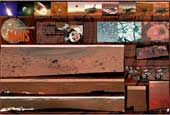
 |
|
|
|
This work primarily concerns itself with the discovery and subsequent naming of our current tally of planetary satellites; a tally incessantly growing. Indeed, Blunck comments that only 50 years ago, the known moons of the major bodies totalled 28; yet thanks to unmanned space probes and the CCD the score now stands at 170. What would Galileo have thought were he to know that the planet’s known attendants have advanced from four to sixty-three! Planetary rings too are encompassed. I was astonished to learn that William Herschel observed Uranian rings (using his 20 foot telescope) not long after his discovery of the planet itself. Although the author does not conjecture on whether these observations were spurious or not, he does mention that a 2007 assessment accords Herschel’s description of their hue with current knowledge. The book is full of juicy snippets like this. Although the author rather disarmingly talks of the book as a manual, this is to diminish its charming content. For the author tells tales. The stories behind satellite discovery and their subsequent naming makes for fascinating reading. His position as a consulting member of the IAU’s working group on planetary system nomenclature brings to this book an intriguing insight into the processes which occur after a new body’s discovery – often as interesting as the discovery itself. Yet there is more. The actual task of naming these objects involves almost every family of mythological pantheons. Such is the detail offered here that the book practically doubles as a literary study of myths and legends. The author missed a trick in excluding Earth’s Moon; probably because of its ‘non-contemporary’ discovery, and a naming that did not involve an IAU committee! However, for completeness, it would have been nice to have given it even a small (megalithic?) mention. Springer have to be congratulated that they pursued completion of this book, despite the author’s sad demise during the copy-editing phase of the project. This book immediately becomes an essential reference work on the Solar System and a fitting memorial to its author. Steve Ringwood |
|
|
|
2009 Yearbook This 132-page special edition features the ultimate observing guide for 2009, a review of all the biggest news stories of 2008, in depth articles covering all aspects of astronomy and space missions for 2009, previews of International Year of Astronomy events and much, much more. This 132-page special edition features the ultimate observing guide for 2009, a review of all the biggest news stories of 2008, in depth articles covering all aspects of astronomy and space missions for 2009, previews of International Year of Astronomy events and much, much more.Infinity Rising  This special publication features the photography of British astro-imager Nik Szymanek and covers a range of photographic methods from basic to advanced. Beautiful pictures of the night sky can be obtained with a simple camera and tripod before tackling more difficult projects, such as guided astrophotography through the telescope and CCD imaging. This special publication features the photography of British astro-imager Nik Szymanek and covers a range of photographic methods from basic to advanced. Beautiful pictures of the night sky can be obtained with a simple camera and tripod before tackling more difficult projects, such as guided astrophotography through the telescope and CCD imaging.Exploring Mars  Astronomy Now is pleased to announce the publication of Exploring Mars. The very best images of Mars taken by orbiting spacecraft and NASA's Spirit and Opportunity rovers fill up the 98 glossy pages of this special edition! Astronomy Now is pleased to announce the publication of Exploring Mars. The very best images of Mars taken by orbiting spacecraft and NASA's Spirit and Opportunity rovers fill up the 98 glossy pages of this special edition!Mars rover poster  This new poster features some of the best pictures from NASA's amazing Mars Exploration Rovers Spirit and Opportunity. This new poster features some of the best pictures from NASA's amazing Mars Exploration Rovers Spirit and Opportunity. |
||||||||||||||||||||||||